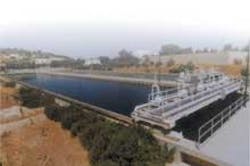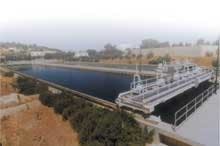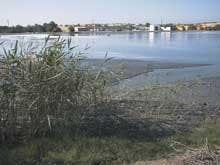Transboundary aquifers —source of conflict or peace?
By Eilon Adar
Nowhere is the impact of water scarcity felt more than in the Middle East where millions of people continuously vie for a share in ever-diminishing supplies. Here, annual renewable water resources amount to about 1,400 m3 per person per year - less than 20% of the global average. Throughout the Middle East, the demand and the actual consumption of water are far beyond the annual rate of replenishment, exceeding the safe yield of the regional water resources.
Since the Biblical Era, water crises in the Middle East region have been a trigger for conflicts. During the last century water use and allocation in the region became an international issue due to a basic shortage of available water resources and an increasing demand for water for national development.
Groundwater reservoirs are considered to be the most reliable source of water in dry lands like those of the Middle East, since the discharge in most of the perennial rivers is prone to large variability associated with temporal variations in rainfall amount and distribution. All groundwater reservoirs in the Middle East are shared by at least two countries. Such is the significance of water in the Middle East that its allocation is prominent in the existing peace treaty between Israel, Jordan, and the Oslo agreement with Palestine, and will play a major role in all future negotiations.
Experts say that the successful development of the Middle East and its political stability rests largely on the sustained supply of usable water to all countries of the region.
All major groundwater sources in the Middle East cross international boundaries, including the coastal Mediterranean and mountainous aquifers that are mutually exploited by Israel and the Palestinians. The deep western Nubian sandstone aquifer extends over Sinai (Egypt) and the Negev desert (Israel). Both Jordan and Saudi Arabia exploit the Disi aquifer. The Azrak aquifer is partly replenished over the southern Syria Mountain ridge (Jabel Druze) and extends over eastern Jordan. Israel and Jordan share the transboundary Arava alluvial aquifer in the Jordan Rift Valley, and Syria, Israel and Lebanon all exploit the Jordan River resources. Management of groundwater exploitation from transboundary aquifers must include sharing the amount of available water and maintaining its quality to assure safe groundwater yields for future generations.
Extensive development of groundwater reservoirs in the recharge zones could affect both water quality and storage capacity for downstream riparian users. This would potentially serve as a major trigger for international conflict over maintaining the water rights of groundwater users sharing reservoirs.
Quantitative assessment of groundwater fluxes and sources of recharge is essential for the common use of local groundwater resources in groundwater basins with transboundary aquifers. Mutual groundwater management that includes a firm control of water exploitation and maintenance of groundwater quality must be obtained in order to guarantee safe groundwater exploitation for years to come. Each partner should use the groundwater reservoir in such a way that will preserve its original water quality. If groundwater quality is expected to change, all partners must be aware of the fact and agree upon a common management policy.
The only way to maintain or control the quality of a mutually exploited aquifer is qualitatively and quantitatively to identify all sources of recharge, and the flow pattern including the magnitude of groundwater fluxes into and within all water bearing layers. Often, common hydrological models cannot be used in complex hydrogeological groundwater basins due to lack of hydrogeological information and scarce hydrological data. This eliminates the possibility of achieving a firm compilation of regional groundwater flow patterns, balance and quality distribution. A quantitative knowledge of the above-mentioned hydrological elements is necessary for joint management and sustainable groundwater exploitation of transboundary groundwater basins.
Israel-Palestine
International law views transboundary water resources, including aquifers, as an international resource. Since the recharge zone for the Judea Mountainous aquifer is exposed over Samaria, Judea and the Hebron Mountains, even treated effluents cannot be used locally, for fear of groundwater contamination. A possible workable solution, therefore, is to transfer the effluents to basins whose hydrogeology allows them to be safely treated and used without risking the groundwater environment. In return, fresh water is transported to the region of vulnerable groundwater recharge zone. Trading treated effluents for potable fresh water may be proposed as a feasible solution leading to practical co-operation between Israel and Palestine.
Israel is committed to adhering to bilateral (Israel-Palestine, Israel-Jordan) and other unofficial international (regional) water agreements.
Future water conflicts can be averted provided that the water exploitation potential will be assessed based on:
• Quantitative and qualitative assessment of existing water resources;
• Integrated planning and combined management of international water resources (aquifers and streams);
• Maintaining (by all partners) of soil and groundwater ecosystems and water quality for downstream riparian users;
• Planning and developing additional water resources following the prediction of future quantity needs for the various types of water qualities.
While the Israeli-Arab conflict persists at a high pitch, water is a key area where both sides tread with extreme caution. Both Israelis and Palestinians view the water and wastewater spheres as crucial, and oppose any damage to water and wastewater infrastructure. The Israeli-Palestinian Joint Water Committee, an outcome of the Oslo accords, signed a "joint declaration for keeping the water infrastructure out of the cycle of violence." The two sides called on all those involved in the current crisis "not to harm in any way the professional teams that conduct regular maintenance operations related to the water and wastewater infrastructure. The two sides are taking all possible measures to supply freshwater and treat the wastewater in the West Bank and Gaza Strip to maintain the sub-surface groundwater ecology.
Jordan and her neighbours
All major aquifers in Jordan such as the Azrak basin (North-East) or the Disi aquifer (in the South) are international water reservoirs. Some of the recharge into the Azrak aquifer (which supplies water to northern Jordan and Amman and other northern cities) takes place over Jabil-el-Arab (or Jabil-el-Druze) mountains in southern Syria.
The Disi aquifer, which is considered the only groundwater reservoir capable of sustaining future development for Jordan, is heavily exploited across the border in Saudi Arabia. South of the border, the Saudis use the water mainly for growing grain, a very low efficiency use of a precious source of fresh water in the desert, which is essential for the future water security of Jordan. A new water conduit from the Disi aquifer in the southern Jordan desert to Amman is undergoing its initial stages of construction.
Jordan and Israel share the Arava Valley aquifer, between the Red and the Dead Seas. After intensive study of the future potential of this aquifer, concerning the quality and safe yield quantity, Israel and Jordan reached an agreement for mutual future development of this transboundary international aquifer. This agreement is included in the 1994 peace treaty between Israel and Jordan.
Furthermore, it has been proven in the peace treaties with Jordan that cooperation on the management of trans-boundary water resources can, in fact, serve as a powerful trigger for collaboration and co-existence.
All water resources in the Middle East, including major surface water and groundwater reservoirs, are tightly interconnected. Water distribution systems in the West Bank and Gaza are combined with Israeli water network systems. Could this be the reason that these systems remain unharmed by terror activities?
Author's noteEilon Adar is the director of the Institute for Water Sciences and Technologies(IWST) at The Blaustein Institutes for Desert Research (BIDR), Ben-Gurion University of the Negev, Israel. For more information, contact him at email: [email protected]


